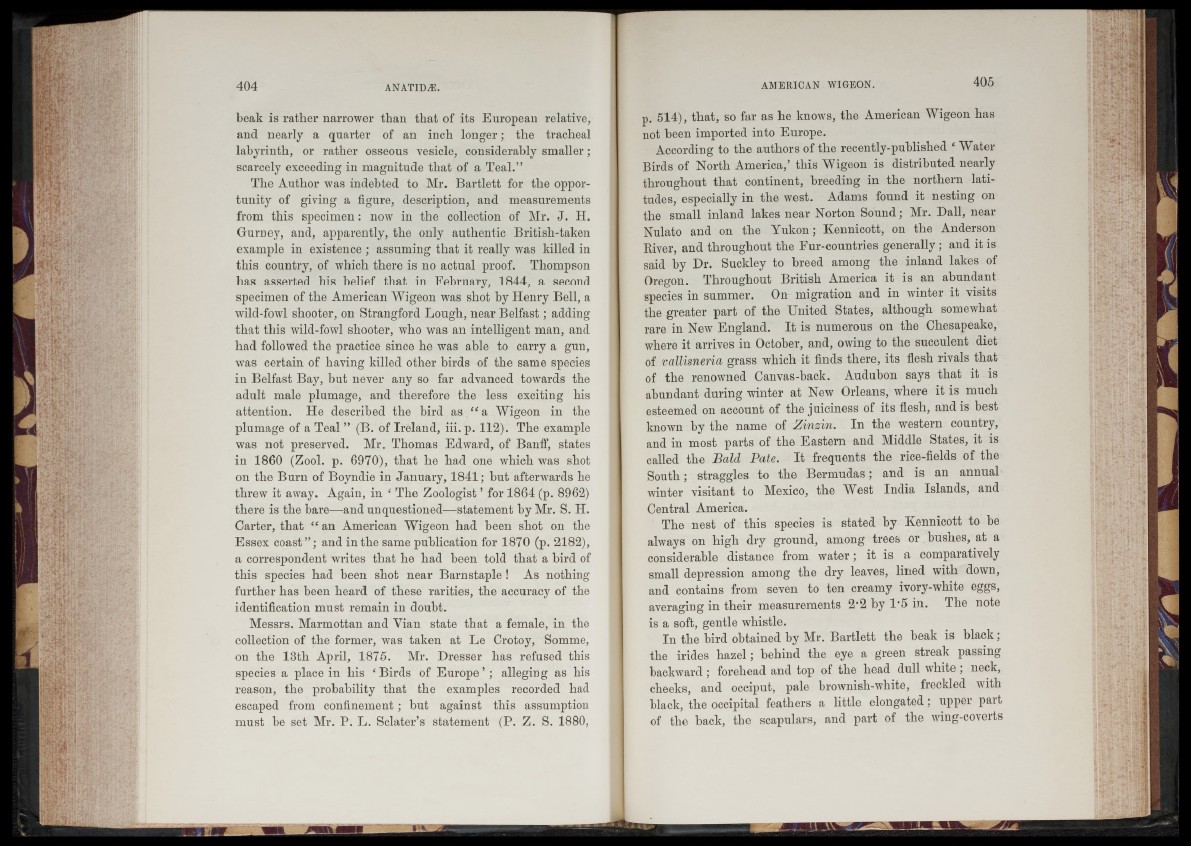
beak is rather narrower than that of its European relative,
and nearly a quarter of an inch longer; the tracheal
labyrinth, or rather osseous vesicle, considerably smaller;
scarcely exceeding in magnitude that of a Teal.”
The Author was indebted to Mr. Bartlett for the opportunity
of giving a figure, description, and measurements
from this specimen : now in the collection of Mr. J. H.
Gurney, and, apparently, the only authentic British-taken
example in existence ; assuming that it really was killed in
this country, of which there is no actual proof. Thompson
has asserted his belief that in February, 1844, a second
specimen of the American "Wigeon was shot by Henry Bell, a
wild-fowl shooter, on Strangford Lough, near Belfast; adding
that this wild-fowl shooter, who was an intelligent man, and
had followed the practice since he was able to carry a gun,
wras certain of having killed other birds of the same species
in Belfast Bay, but never any so far advanced towards the
adult male plumage, and therefore the less exciting his
attention. He described the bird as “ a Wigeon in the
plumage of a Teal ” (B. of Ireland, iii.p. 112). The example
was not preserved. Mr. Thomas Edward, of Banff, states
in 1860 (Zool. p. 6970), that he had one which was shot
on the Burn of Boyndie in January, 1841; but afterwards he
threw it away. Again, in ‘ The Zoologist ’ for 1864 (p. 8962)
there is the bare—and unquestioned—statement by Mr. S. H.
Carter, that “ an American Wigeon had been shot on the
Essex coast” ; and in the same publication for 1870 (p. 2182),
a correspondent writes that he had been told that a bird of
this species had been shot near Barnstaple ! As nothing
further has been heard of these rarities, the accuracy of the
identification must remain in doubt.
Messrs. Marmottan and Yian state that a female, in the
collection of the former, was taken at Le Crotoy, Somme,
on the 18th April, 1875. Mr. Dresser has refused this
species a place in his £ Birds of Europe ’ ; alleging as his
reason, the probability that the examples recorded had
escaped from confinement; but against this assumption
must be set Mr. P. L. Sclater’s statement (P. Z. S. 1880,
p. 514), that, so far as he knows, the American Wigeon has
not been imported into Europe.
According to the authors of the recently-published £ Water
Birds of North America/ this Wigeon is distributed nearly
throughout that continent, breeding in the northern latitudes,
especially in the west. Adams found it nesting on
the small inland lakes near Norton Sound; Mr. Dali, near
Nulato and on the Yukon; Iiennicott, on the Anderson
River, and throughout the Fur-countries generally; and it is
said by Dr. Suckley to breed among the inland lakes of
Oregon. Throughout British America it is an abundant
species in summer. On migration and in winter it visits
the greater part of the United States, although somewhat
rare in New England. It is numerous on the Chesapeake,
where it arrives in October, and, owing to the succulent diet
of vallisneria grass which it finds there, its flesh rivals that
of the renowned Canvas-back. Audubon says that it is
abundant during winter at New Orleans, where it is much
esteemed on account of the juiciness of its flesh, and is best
known by the name of Zinzin. In the western country,
and in most parts of the Eastern and Middle States, it is
called the Bald Pate. It frequents the rice-fields of the
South; straggles to the Bermudas; and is an annual
winter visitant to Mexico, the AYest India Islands, and
Central America.
The nest of this species is stated by Kennicott to be
always on high dry ground, among trees or bushes, at a
considerable distance from water; it is a comparatively
small depression among the dry leaves, lined with down,
and contains from seven to ten creamy ivory-white eggs,
averaging in their measurements 2*2 by P5 in. The note
is a soft, gentle whistle.
In the bird obtained by Mr. Bartlett the beak is black;
the irides hazel; behind the eye a green stieak passing
backward ; forehead and top of the head dull white , neck,
cheeks, and occiput, pale brownish-white, freckled with
black, the occipital feathers a little elongated ; upper part
of the back, the scapulars, and part of the wing-coverts